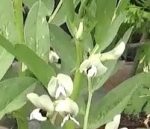 Horse bean is a cool weather annual and a member of the pea family, Fabaceae, that also includes lupines, mimosa, and black locust. It is native to an unidentified part of the eastern Mediterranean area where it has been grown and consumed since 6000 BC or earlier. The plants grow 1.5-6′ tall and have 2-4 stems that are square in cross-section. The pinnate gray-green leaves are 4-10″ long and have 2- 7 leaflets. The summer-blooming flowers are very fragrant and have 5 petals, 2 white standard petals, 2 white wing petals with a black spot, and a white keel petal. The fruit is a leathery pod that is green maturing to dark blackish brown, has a downy surface and contains 3-8 round to oval seeds. The seeds of horse bean are intermediate is size between the larger broad bean seeds and the smaller pigeon bean seeds.
Horse bean is a cool weather annual and a member of the pea family, Fabaceae, that also includes lupines, mimosa, and black locust. It is native to an unidentified part of the eastern Mediterranean area where it has been grown and consumed since 6000 BC or earlier. The plants grow 1.5-6′ tall and have 2-4 stems that are square in cross-section. The pinnate gray-green leaves are 4-10″ long and have 2- 7 leaflets. The summer-blooming flowers are very fragrant and have 5 petals, 2 white standard petals, 2 white wing petals with a black spot, and a white keel petal. The fruit is a leathery pod that is green maturing to dark blackish brown, has a downy surface and contains 3-8 round to oval seeds. The seeds of horse bean are intermediate is size between the larger broad bean seeds and the smaller pigeon bean seeds.
Horse beans seeds have been found in mummy coffins in Egypt suggesting their use as human food although today the bean is widely cultivated in Syria as fodder for cattle.
2 Samuel 17.28 (NIV) Supporters brought supplies for King David’s hungry army as he was camped at Mahanaim.
“brought bedding and bowls and articles of pottery. They also brought wheat and barley, flour and roasted grain, beans and lentils,”
Ezekiel 4.9( NIV) Exekiel is commanded to use several kinds of grains, from coarse to fine, for bread-making in order to extend the supply of food during the seige of Jerusalem.
“Take wheat and barley, beans and lentils, millet and spelt; put them in a storage jar and use them to make bread for yourself. You are to eat it during the 390 days you lie on your side.”
Horse bean needs full sun and average, heavy, moderately moist, well-drained loam in an area with cool summers. Propagation is by seed. Plants are susceptible to damage by aphids, chocolate spot (Botrytis fabae and B. cinerea), rust (Uromyces viciae fabae), black root rot (Thielaviopsis basicola), stem rots (Sclerotina trifoliorum, S. sclerotiorum), root rots and damping-off (Rhizoctonia spp.), downy mildew (Pernospora viciae), pre-emergence damping-off (Pythium spp.), leaf and pod spots or blight (Ascochyta fabae), foot rots (Fusarium spp.), bean yellow mosaic virus, bean true mosaic virus, and bean leaf roll virus.
The genus name, Vicia, is the classical Latin name for vetch. The specific epithet, faba, is the classical Latin word meaning bean. The variety name, equina, is from the classical Latin word equus, meaning horse, and refers to the use of the bean for horse feed.